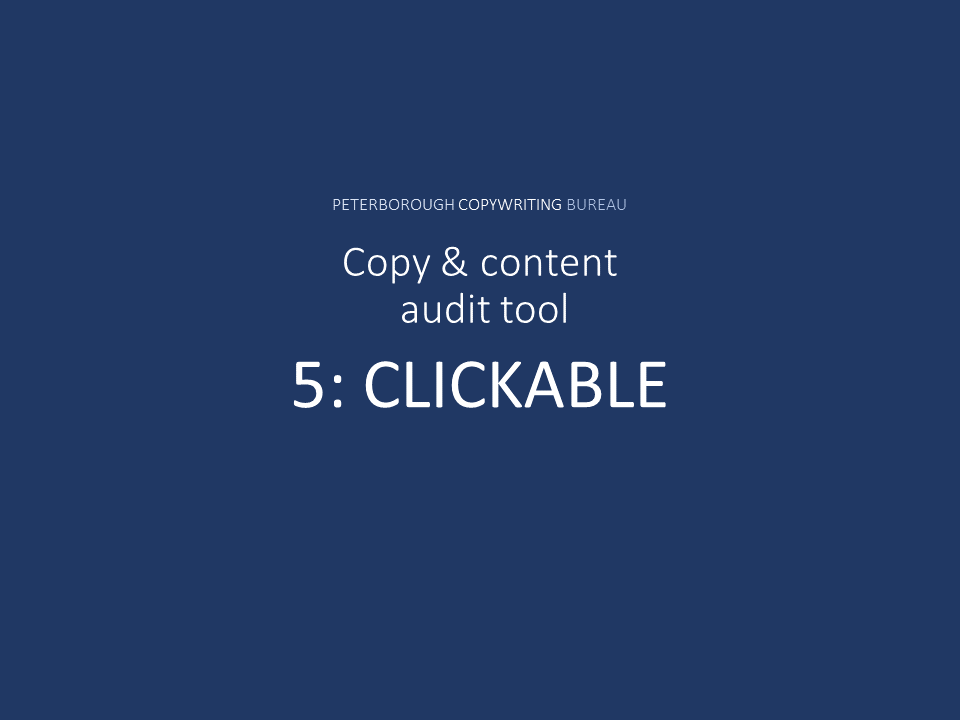Having great online content means little if you aren’t getting people to visit it. This part of the audit assesses the elements needed to attract people to the content.
NOTE: This is part 5 in a ten-part serialisation of my eBook. Please read the introduction first if you are new to the tool.
The question to ask is this: if people just saw just the headline, and maybe an associated image, would they be likely to click through to the content? So, assuming that the content itself is strong, with good customer-focused subject matter, let’s look at those two important elements.
The headline/title
This is sometimes the only thing that someone will be presented with at first, so it had better be good. Understanding what makes a great headline is one of the best skills a copywriter can develop. It could be the subject of its own book, but we don’t have time for that right now so let’s look at a few criteria on which to base this part of the audit.
1. What does the data tell you? If you’re lucky, you’ll be able to start with data available on click rates. For example if the title was used as a link in a customer email or social media post, how did it perform compared to your average rate?
2. Is there anything that grabs attention? Does the headline instantly suggest to readers that the content will be interesting, unique, useful, exiting or funny? You might be surprised at which headlines are performing brilliantly for other marketers. There’s great analysis from BuzzSumo at https://buzzsumo.com/blog/most-shared-headlines-study/ that looks at 100 million headlines. It’s well worth a read because the results are likely to change the way you think about headline writing.
3. Does it resonate with your target audience? I sometimes write down headlines I click on, building up a list that I can draw inspiration from. My list includes this one:

I like this because it’s about me (I’m a marketer) a subject of interest (paid search) and it suggests urgency (changes are going to impact me). Let’s turn that into a simple formula for writing this type of headline:
Target audience + subject matter + sense of urgency = clickable headline.
Keep a note of the headlines you click on. Create your own list and analyse them to build your own examples of winning formulae to take inspiration from.
The image
Social media is driven by images. Hubspot found that Facebook posts that include images receive almost three times as much engagement as plain-text content. So, if your content has an image that appears in emails, on social media or elsewhere:
-
Is it a good one?
-
Is it likely to compel people to click to the content?
-
And if there is no image, can you add one?
Some solutions for ‘clickable’ problems
Here are some easy fixes for issues that are impacting on the ‘clickable’ performance of your content.
Option 1: write a better headline
Here’s an easy technique for writing better headlines that I’ve been using for about 20 years.
-
Step one: write a simple headline.
-
Step two: brainstorm a few alternatives for each of the words.
-
Step three: create a new headline from the new words.
Here’s an example of the technique in action:
Simple headline |
Newsletter |
wins |
top |
award |
Alternative words |
Magazine. Journal. Paper. Publication. Pamphlet. Newssheet. |
Scoops. Triumphs. Scores a victory.
|
Best.
|
Gong.
|
New headline ideas: |
Magazine scoops supreme honourIt’s official: journal is a world-beater!Major trophy as newssheet triumphs |
|||
Option 2: include better images
Can you swap out an existing poor image for one that is more directly tied in with the content? If money is an issue and you can’t stretch to buying images, check out free photo libraries like Unsplash and Pexels. For fast and free photo editing, I like Befunky.
Another approach is to do what Brian Sutter suggests: “Level two for marketers is to convert part of their content into an image that works as standalone content. For example, if you have educational content, put together an image of the basic steps to follow, then bundle those steps into one image.”
Option 3: reshape content
If the real problem here is that the subject matter itself lacks click appeal, it could be time to do an edit. Maybe you can turn an article into a ‘how-to’ type piece that lends itself to a strong headline.
Use tools that tell you what’s trending to help you develop some themes and topics. BuzzSumo is a fantastic tool to analyse what’s trending. Type in your subject of interest and you’ll get a page of results, with stats on social media engagement. You can also sign up to get a notification every time something significant happens around that subject. And of course, Twitter and Facebook have ‘trending’ tools that let you keep track of hot topics.

